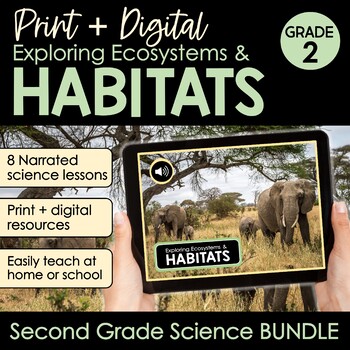Habitats & Ecosystems Second Grade Science BUNDLE NGSS
- Zip
- Google Apps™

What educators are saying
Products in this Bundle (2)
Description
This second grade habitats and ecosystems science bundle is an in-depth, 3-week science resource carefully designed with literally everything you need to teach NGSS and many state science standards for 2nd grade Interdependent Relationships in Ecosystems. The unit addresses NGSS 2-LS4-1, 2-LS4.D.
This bundle includes both the printable unit and the digital companion unit for the 2nd grade habitats and ecosystems science units. Please see the previews for both units for details and all materials included.
This science bundle includes 15 days of highly engaging science lessons and narrated audio slides.
Lesson Topics:
- Identifying Habitats & Ecosystems
- Exploring Land Habitats
- Adapting to Land Habitats
- Exploring Water Habitats
- Adapting to Water Habitats
- Comparing Habitat Diversity
- Habitat Interdependence
- Protecting Habitats
Each ready to teach lesson comes with an instructional PowerPoint, detailed, scripted lesson plans, response journal activities, differentiated quizzes, and hands-on experiments.
NOTE: You will need a Google account or Google Classroom to access the digital versions on Google Slides. Teacher directions for using and assigning digital resources in Google Classroom are included. You will need access to YouTube to play the audio lessons.
Printable unit includes:
- A complete Teacher’s Guide with a 15-day Pacing Guide that can be shortened to fit your schedule
- Standards alignment pages for each lesson
- Teacher planning binder with cover and sections
- 15 Days of detailed, scripted lesson plans.
- 6 Hands-on investigations with guided lab procedures and step-by-step directions with photos.
- An in-depth Teaching PowerPoint
- Essential questions posters and learning target cards
- Guiding questions & objectives cards
- Student journal/workbook
- Vocabulary cards + full page posters
- 4 Literacy and math-based science centers
- Quizzes for each lesson in 2 formats (short written response or fill in the blank) with answer keys
- Final unit test with optional pages for differentiation & answer keys
- Related video links
Lab Experiments/ Investigations
Students explore micro-habitats, simulate and demonstrate adaptations, build models, and conduct investigations in the following labs:
- What Lives At School? Exploring Micro-habitats
- How Do Fish Breathe Underwater? Gill demonstration
- Build a Model Water Plant
- Design & Build a Land and Water Habitat on a Plate
- How Do Water Animals Stay Warm? Blubber Demonstration
- Comparing Habitat Diversity with simple models
Habitats/Biomes Addressed
Deserts, rainforests, deciduous, coniferous, and temperate forests, grasslands, tundras, oceans, tide pools, coral reefs, wetlands, swamps, marshes, rivers, and streams.
Students explore ecosystems, micro-habitats and urban habitats. They discover ways ecologists, engineers, and other scientists collaborate to protect and restore endangered habitats.
4 Science Centers (in both printable + digital format)
Reinforce science content as students practice these math & literacy skills:
- Cause & Effect
- Sorting & Classifying
- Applying Vocabulary
- Math word problems using science content
Digital unit includes the following on Google Slides:
- 7 Narrated lessons with audio slides (You will need access to YouTube to play the audio files.)
- 7 Interactive journal activities
- 14 Quick Check quizzes in multiple-choice and fill-in-the-blank formats
- Differentiated unit test
- Interactive extension activities
*Please see the preview of both units for details and pictures of all resources included in this bundle.
CLICK HERE for a list of materials needed to do the labs.
Note: This is a very large unit that downloads as a zipped (ZIP) folder with 3 separate files inside. CLICK HERE for directions to open a ZIP file.
Happy teaching!
Linda Kamp
Around the Kampfire
Click here to see all 2nd grade science units & bundles.
Scientists & Scientific Method
Plant & Animal Interdependence
Click here to see all 3rd grade science units & bundles.





